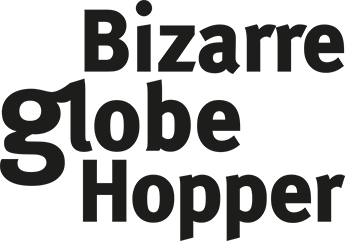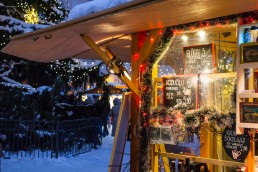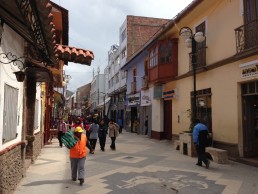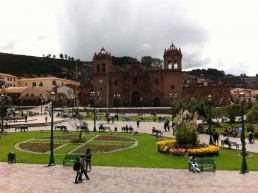Traveling by bus from Cusco to Puno, on the shores of the magnificent Lake Titicaca is much more rewarding in Peru than just flying between these two cities. On the way, you’re also able to visit many interesting places from once one of the holiest shrines of the Inca empire to a tiny village museum.
Buying the Bus tickets and the First Stop in Andahuaylillas
Many bus companies are driving the route Cusco – Puno, but we chose the Inka Express because it seemed the best choice according to all the reviews. The route goes via the Wiracocha Pan Andino (“The route of the All-God”) -highway and the buses also make five stops on the way to see some exciting attractions, and you’ll also have lunch in one village on the way.
This of course makes it last longer, overall for about 10 hours but you will see quite a lot during the trip, and it’s always nice to stretch your legs from time to time. The buses leave at 7 AM from Cusco, and I strongly suggest to buy your ticket beforehand on the internet! You can buy them directly from their website. You’ll also save 10% off the price if you book online.
The first stop comes pretty quickly, about 30 minutes after departure in a village called Andahuaylillas. The attraction to see here is the Jesuit Church which is decorated with so much gold that you could buy a whole year’s worth of food to the entire village if you’d sell it.
It’s not allowed to take photographs inside the church, but if you don’t use flash and do it discreetly without the guide noticing, it’s possible – at least if you just use your phone. There are often vendors selling all kinds of stuff around the market square where the church is located, and actually, they can be more interesting to explore than the church. The stops of the bus are also pretty tightly scheduled so you have to prioritize what exactly you want to see!
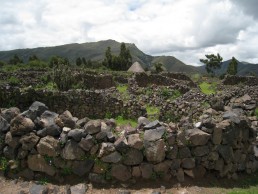
At the Holy Shrine of Wiracocha in Raqchi
The second stop is much more interesting. It’s the Wiracocha ruins of the village of Raqchi. One of the holiest shrines of the whole Inca Empire has once been in here. Today there are some quite impressive structures still standing. The area is also pretty big, and you could easily spend a long time just photographing.
Your guide will tell you shortly about the history of the shrine and afterwards you can explore around independently (or go with the group, if you like). Just take a notice of the time when you have to be back on the bus, though. We didn’t pay enough attention and the rest of our group ended up waiting for us for about 15 minutes. Our apologies were accepted, but our guide seemed not so happy.
Here are also some good vendors in the village and try to have at least little time to roam through them. Here would be a great place to buy some souvenirs because the starting prices are lower than in Cusco. However, how much you will end up paying, depends on your bargaining abilities. But you’ll get plenty of practice here, if you like.
From Raqchi there’s only a 20 minutes ride to the village called Sicuani where you will have your included lunch. This kind of buffet meals tends to be average or below in quality, but this one made a nice exception. There were many choices to choose from, and the selection also included some healthier choices like some excellent quinoa!
There were also different kinds of meat (including beef and alpaca), pasta, rice, salads, bread and a nice selection of desserts. Good value for the price. Drinks were not included, though. The lunch break is 45 minutes and after it, the journey will continue to the highest point of the route in the pass of Abra La Raya. It is located approx. 4335 m above sea level. There’s only a brief stop, barely enough to take a photo of yourself with the sign showing the altitude but then again there’s not much else to see.
Seeing Inca Mummies in the Little Village of Pucará
The fifth and last stop before Puno is in the village of Pucará. You’ll visit the tiny museum there but also the village with its narrow and empty streets, and traditional houses is an attraction in itself. It looks like hundreds of other villages in the Andes, but it has some strange kind of charm. It reminded me remotely of some of the communities I’ve seen in the Himalayas. In the museum itself, there’s not much else to see than the two Inca mummies, but they alone are worth the visit. Besides the mummies, the exhibition shows mainly some ancient tools of the Incas and other equipment.
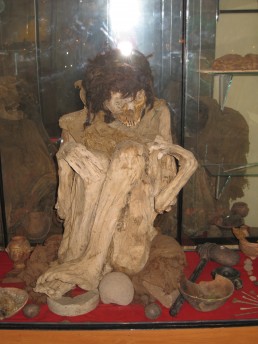
Driving Through the Concrete City andFfinally Reaching the Shore of Lake Titicaca
The scenery on the rest of the journey was quite dull and harsh. We also drove through the airport town of Juliaca, and it looked like a depressing, grey town from the East Germany with its unfinished buildings made of concrete and not much green anywhere.
The guide told us many non-flattering facts about Juliaca and also warned that it could potentially be quite dangerous to tourists. How dangerous exactly, remained unsure but it did not look like a cosy, neither a very welcoming place. The guide gave an image of a city that would be almost hostile towards tourists and when moving around you should be extremely careful.
There is also a lot of black market business in Juliaca. People are smuggling lots of goods from Bolivia’s side and then selling it in Juliaca. Therefore as well as the state and the town are losing a lot of tax income. Eventually, this will lead to a poor infrastructure and public health care, among other bad social impacts.
From Juliaca, you’ll continue your ride in a pretty dull landscape but then just before arriving in Puno you can see the great lake Titicaca on the left side of the road. That scenery was maybe the best one seen during the whole journey. The bus drives slower on this stretch so you can take some photographs from the bus window if you’re quick enough. Regrettably, the bus won’t actually stop here so that you could take some actual, good shots. But then again it has to arrive in Puno in a schedule.
You May Also Like to Read:
The Christmas Market of Tallinn’s Old Town
Feel the spirit of the Middle Ages at the Rathaus Square in Tallinn, filled with the tiny cottages selling everything from handicrafts to mulled wine.
Celebrating Virgen de la Candelaria Festival in Puno, Peru
Celebrating the biggest festival of the year in Puno, Peru - the Virgen de la Candelaria. The streets are filled with music, dance performances and parades for almost 24/7. Join in with the devils and other strange creatures!
Coca Tea and Death Rituals at the Inca Capital of Cusco
Take quirky and interesting day trips around Cusco. Visit Inca ruins; the peculiar Q´enqo, old Sacsaywaman, and see the royal mummies.
